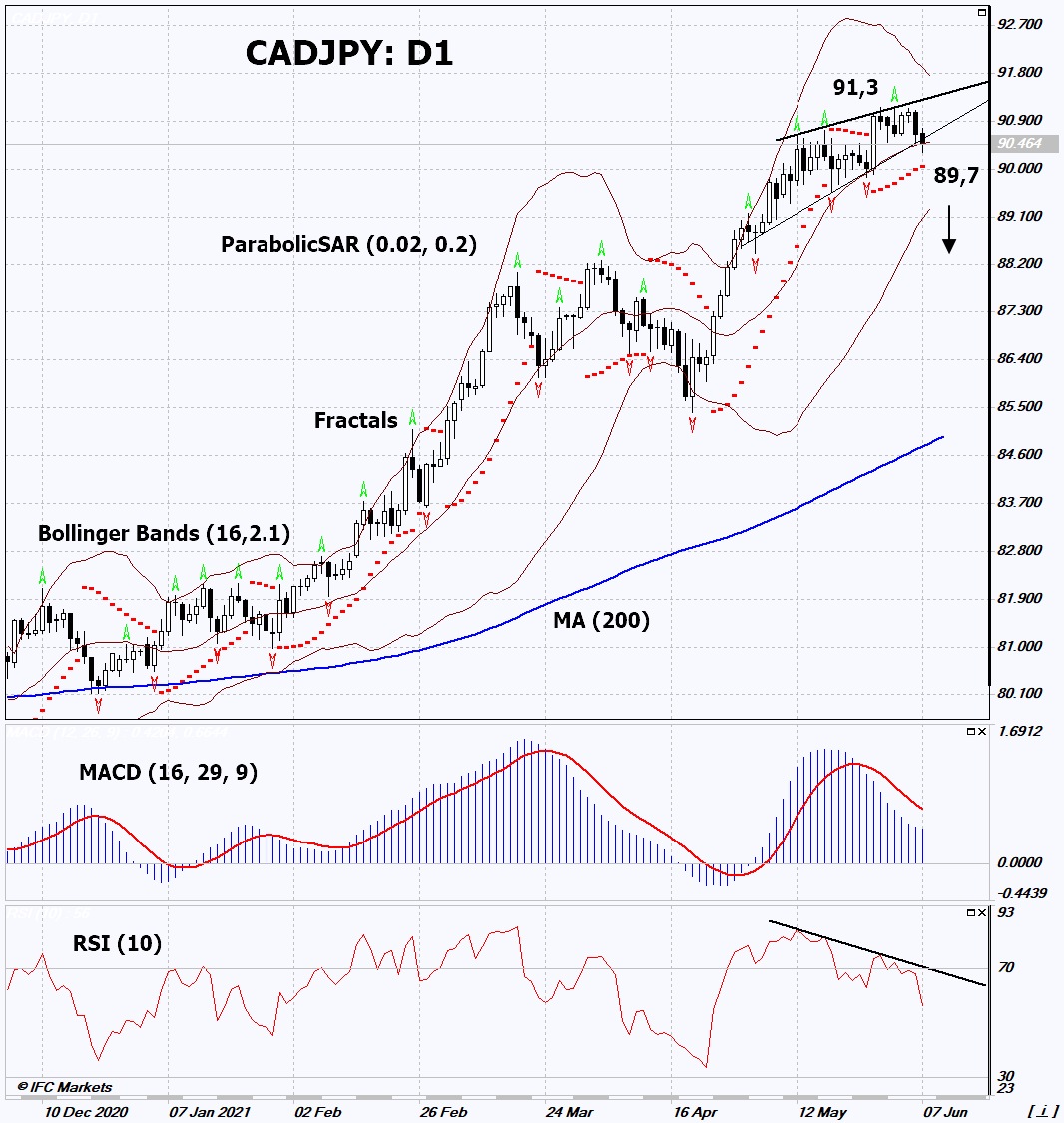- Phân tích dữ liệu
- Phân tích kỹ thuật thị trường
CAD/JPY Phân tích kỹ thuật - CAD/JPY Giao dịch: 2021-06-08
CAD/JPY Tổng quan phân tích kỹ thuật
Dưới 89,7
Sell Stop
Trên 91,3
Stop Loss
| Chỉ thị | Tín hiệu |
| RSI | Bán |
| MACD | Bán |
| MA(200) | Trung lập |
| Fractals | Trung lập |
| Parabolic SAR | Mua |
| Bollinger Bands | Trung lập |
CAD/JPY Phân tích biểu đồ
CAD/JPY Phân tích kỹ thuật
On the daily timeframe, CADJPY: D1 is correcting downward and has broken down the support line of the triangle and the short-term uptrend. A number of technical analysis indicators have formed signals for further decline. We do not exclude a bearish movement if CADJPY falls below the last lower fractal and the Parabolic signal: 89.7. This level can be used as an entry point. The initial risk limitation is possible above the last fractal high and high since January 2018: 91.3. After opening a pending order, move the stop to the next fractal maximum following the Bollinger and Parabolic signals. Thus, we change the potential profit/loss ratio in our favor. The most cautious traders, after making a deal, can go to the four-hour chart and set a stop-loss, moving it in the direction of movement. If the price overcomes the stop level (91.3) without activating the order (89.7), it is recommended to delete the order: there are internal changes in the market that were not taken into account.
Phân tích vĩ mô Forex - CAD/JPY
Economic activity has increased in Japan. Will CADJPY quotes go down?
A downward movement signifies a weaker Canadian dollar and a stronger Japanese yen. On Monday, June 7, Japan released two PMIs, which reached pre-covid levels. The preliminary Leading Composite for April exceeded the forecast and amounted to 103 points. If it receives confirmation in the 2nd assessment, then it will be the maximum from September 2018, before the coronavirus epidemic. Also on Monday, the Coincident Index for April was released in Japan. It amounted to 95.5 points, which is the highest since February 2020. On June 8, Japan will release its final Q1 GDP. It may affect the yen rate if it differs greatly from its initial estimate (-1.3%) in quarterly terms and (-5.1%) in annual terms. According to forecasts, the fall in GDP will be less than the 1st estimate and amount to (-4.8%). For the Canadian dollar, weak data on the labor market for May may become a negative factor. Unemployment in Canada increased to 8.2% from 8.1%. The number of new jobs fell more than expected. In addition, the outlined decline in oil prices due to the reduction in oil imports to China in May may become a negative factor for the Canadian dollar. On June 9, a meeting of the Bank of Canada will take place. A rate change of 0.25% is not expected, but it may affect the dynamics of the Canadian dollar.
Lưu ý:
Bài tổng quan này mang tính chất tham khảo và được đăng miễn phí. Tất cả các dự liệu trong bài viết được lấy từ các nguồn thông tin mở và được công nhận đang tin cậy. Nhưng không có bất kỳ đảm bảo nào rằng thông tín hoàn toàn đang tin cậy. Sau này không điều chỉnh lại nữa. Tất cả thông tin trong bài tổng quan, bao gồm ý kiến, chỉ số, biểu đồ và khác chỉ mang tính chất tham khảo và không phải là lời khuyên đầu tư. Tất cả bài viết này không được xem xét như lời khuyên thúc đẩy để giao dịch. Công ty IFC Markets và nhân viên không chịu trách nghiệm cho bất kỳ quyết định của khách hàng sau khi đọc xong bài tổng quan.


